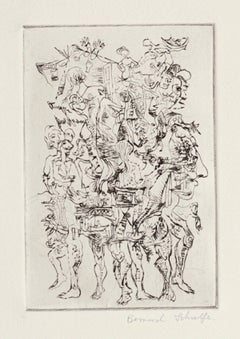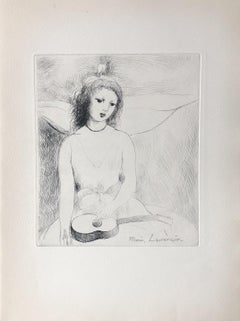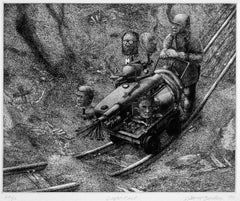Bernard Schultze Prints and Multiples
German, 1915-2005
Bernard Schultze (1915-2005) was a painter, a leading figure in German Informal Art. He was born in Schneidemühl (East Prussia) and was 6 years old when he moved to Berlin, where his father held judicial office. When he was 19, he enrolled at Berlin’s Academy of Art Education and at the Academy of Fine Arts in Düsseldorf. After graduating in 1939, he was sent to the front, in Russia and Africa, where he was to say until the end of the war. After spending two years in Flensburg as a refugee, he joined his father, who had been appointed senior judge at the Frankfurt court. In autumn 1949, he made the acquaintance of the artist Ursula Bluhm at the Franck Gallery, whom he married 6 years later. In 1951, Bernard Schultze, whose early works had been destroyed when Berlin was bombed in 1944, produced his first informal paintings and paid his first visit to Paris, where he later stayed at regular intervals.
He was one of Europe’s leading practitioners of gestural abstraction. In1952, he founded the Quadriga group of artists along with Karl Otto Götz (1914-2017), Otto Greis (1913-2001) and Heinz Kreutz (1923-2016), inaugurating “Informal Art” in Germany. In the early years of his career, he adopted André Breton’s point of view, according to which creative processes must be guided by the unconscious, which led him to develop a unique pictorial vocabulary in resonance with other artistic practices prevalent in the first half of the 20th century and an existential aesthetic of destruction reflected in tattered, distorted structures and colours evocative of wounds and decomposition, certainly connected with his own experience of war.
In 1972, he was elected to Berlin’s Academy of Fine Arts. For two years (1980-1981), a major retrospective of his work made the rounds in Germany (Düsseldorf, Berlin, Frankfurt and Saarbrucken). In the 1980s and beyond, the painter was awarded numerous prizes and held numerous exhibitions, including one devoted to his works on paper at the Albertina in Vienna (1984). The end of the decade also saw his first large-format oil paintings, which could reach sizes of up to 15 m2, in which he soon introduced (1991) “tabuskri”, intersections of painting and graphic structures. During the years that followed, the artist worked on developing large-format bronzes and etchings. In 1995, he moved to Rue du Cygne in Paris, which became his second home. Thenceforth, he divided his life between Paris and Cologne, where he died on 14 April 2005, a few weeks before his 90th birthday.
Bernard Schultze’s works feature in a great many collections across the world, including at the Ludwig Museum in Cologne, the Museum of Modern Art in Céret, the Centre Pompidou in Paris, the Tate Collection in London, the Boijmans Van Beuningen Museum in Rotterdam and the MoMA in New York.to
1
1
Overall Width
to
Overall Height
to
1
1
2
1,162
899
842
802
2
1
1
2
2
2
2
2
1
1
2
1
1
Artist: Bernard Schultze
Carnival - Etching by Bernard Schultze - 1964
By Bernard Schultze
Located in Roma, IT
Carnival is a beautiful etching, realized in 1964 by the German painter and engraver Bernard Schultze (1915–2005) a leading exponent of abstract painting and an enormously prolific artist.
Hand-signed on the lower right.
Good conditions.
The artwork represents a spirit of carnival through intrigued lines in which figures are combined, the strongness of strokes makes a unique feeling of the carnival scene, the chaotic carnival sounds visualized through aesthetic features, by the sharp imagination of the artist.
Bernard Schultze (1915–2005) was one of the largest German painters of the Abstraction in the middle of the 20th century. a painter who co-founded the Quadriga group of artists along with Karl Otto...
Category
1960s Contemporary Bernard Schultze Prints and Multiples
Materials
Etching
Hommage a Picasso, Etching by Bernard Schultze
By Bernard Schultze
Located in Long Island City, NY
Artist: Bernard Schultze, German (1915 - 2005)
Title: Hommage a Picasso
Year: 1973
Medium: Etching, signed and numbered in pencil
Edition: 75/90
Image Size: 21.5 x 17.5
Size: 30 x 21...
Category
1970s Modern Bernard Schultze Prints and Multiples
Materials
Etching
Related Items
Young Girl With a Guitar - Original Etching Signed in The Plate
By Marie Laurencin
Located in Paris, IDF
Marie Laurencin
Young girl with a guitar
Original etching, 1945
Signed and dated in the plate
Edition of 340 copies, unnumbered as issued
On Lana vellum, size 33 x 25,5 cm (c. 13 x ...
Category
1940s Modern Bernard Schultze Prints and Multiples
Materials
Etching
$478
H 13 in W 9.85 in
Light Rail, Etching, Heads on a Rail Car Traveling Through a Surreal Landscape
By David Becker
Located in Chicago, IL
An etching is an intaglio printmaking process in which lines or areas are incised using acid into a metal plate in order to hold the ink. In etching, the plate can be made of iron, copper, or zinc. Once etched, the plate is then printed onto paper.
David Becker
Light Rail...
Category
1980s Contemporary Bernard Schultze Prints and Multiples
Materials
Etching
$1,200
H 28.5 in W 35.5 in
Felicitas / Ans Van der Kuylen - Original Etching by M. Fingesten
By Michel Fingesten
Located in Roma, IT
Image dimensions: 10.5x8.5 cm
Original Ex Libris includes passpartout. Hand signed and signed on plate.
Very good conditions.
Michel Fingesten
Michel Finkelstein, known as Fingeste...
Category
Early 20th Century Modern Bernard Schultze Prints and Multiples
Materials
Etching
$567
H 11.82 in W 9.45 in D 0.12 in
Ex Libris Happy New Year 1938 - Original Etching by M. Fingesten
By Michel Fingesten
Located in Roma, IT
Image dimensions: 15x12 cm
Original Ex libris realized for Gianni Mantero in occasion of the New Year 1938. Original Etching on paper. Includes passpartout. Includes passepartout; n...
Category
Early 20th Century Modern Bernard Schultze Prints and Multiples
Materials
Etching
$418
H 11.82 in W 9.45 in D 0.12 in
Portrait of Pierre Guastalla - Etching by Halman Hagelstam - 1926
Located in Roma, IT
Portrait of Pierre Guastalla is an original etching on paper realized in 1926 by Halman Hagelstam (1899-1941)
Hand-signed and dated on the lower right in pencil with the dedication ...
Category
1920s Modern Bernard Schultze Prints and Multiples
Materials
Etching
$418
H 14.97 in W 11.03 in D 0.04 in
The Death - Original Etching by Ricardo de los Ríos - 1880 ca.
Located in Roma, IT
The Death is an original etching on paper realized by Spanish artist Ricardo de los Ríos in 1880 ca.
Signed on the plate on the lower center.
In very good condition.
Included a Pa...
Category
1880s Modern Bernard Schultze Prints and Multiples
Materials
Etching
$298
H 10.63 in W 8.08 in D 0.04 in
Testa Colossale Creduta Rappresentare la Spagna - Etching by F. Cecchini
By Francesco Cecchini
Located in Roma, IT
"Testa colossale creduta rappresentare la Spagna" (Kolossal head commonly belived to represent Spain) is a wonderful black and white etching on paper, realized by the Italian artist Francesco Cecchini (1790 - 1820 ca), after Agostino Tofanelli (Lucca 1770 - Rome 1834) , as the inscriptions on plates on lower margins report “Agostino Tofanelli delineò/ Francesco Cecchini incise Roma”.
This original print is numbered on plate in Roman numerals on higher margin: “Tom II /Tav XX" and is a plate from the series "Illustrazioni de'Monumenti scelti Borghesiani già esistenti nella Villa sul Pincio () date ora per la prima volta in luce dal cav. Gio. Gherardo De Rossi e da Stefano Piale sotto la guida di Vincenzo Feoli", by Ennio Quirino Visconti, published by Stamperia de Romanis in Rome, 1821.
This old master’s original prints representing a precious piece of the Borghese collection is in excellent conditions with a usual yellowing of the paper at the edges, some light signs of the time (some little wormholes on the left margin beyond the marginal line of the matrix and a thinning of the paper along the margins) but with fresh impression.
Illustrazioni de' Monumenti scelti Borghesiani
This collection in two volumes is a beautifully detailed catalog of classical sculptures collected by Prince Borghese (1730-1800) in his Villa on the Pincio. Ennio Quirino Visconti (1751 - 1818) wrote the texts that accompany the large branches depicting. To these writings, which were found and made available by the son of the illustrious archaeologist, the publishers added only a few illustrations relating to some minor monument of which copper had already been engraved.
The engraved title-plate are signed by draughtsmen like Agostino Tofanelli, Stefano Tofanelli, Bernardino Nocchi, Domenico de Angelis or Teodoro Matteini, and by engravers Pietro Fontana Veneto, P. Vitali, Pietro Bettelini, Giovanni Folo Veneto, Giovanni Brunetti da Ravenna, Giovanni Ottaviani, Francesco Cecchini, Gio. Batta. Leonetti, Girolamo Carattoni, Domenico Cunego, Luigi Cunego, Alessandro Mochetti, Luigi Pizzi, Angelo Campanella or Giacomo Bossi.
The Volume I shows ancient full-length statues, of the Borghese warrior...
Category
1820s Modern Bernard Schultze Prints and Multiples
Materials
Etching
$827
H 22.96 in W 17.25 in D 0.04 in
Somewhere to Dream - still life, hand signed, Roy Fairchild
By Roy Fairchild
Located in London, GB
This serigraph print is for sale from Roy Fairchild's Personal Collection. This print will come with a certificate of authenticity from London Contemporary Gallery and a unique signed letter from Roy Fairchild himself authenticating the work and detailing that this is from his personal collection.
Roy Fairchild-Woodard was born in 1953 in Surrey, England. He currently lives and works most of the year in the peaceful environment of his Country home. The rest of the year he travels throughout Europe; Italy in particular, to obtain new sources of inspiration. His affinity with Italy is the painters of the Renaissance, especially their frescos, tapestries and paintings.
The plasterwork of the frescos is alluded to in his use of plaster as a base for his acrylic and oil overpaints. Also the influence of Egon Schiele and Gustave Klimpt can be seen in his occasional reference of line and decoration.
He received a degree in graphic design and started working under the name Woodard to produce more commercial...
Category
21st Century and Contemporary Contemporary Bernard Schultze Prints and Multiples
Materials
Etching, Aquatint
$689
H 25.6 in W 31.5 in D 0.2 in
Still Life with Eleven Objetcs in a Sphere - Etching by Giorgio Morandi - 1942
By Giorgio Morandi
Located in Roma, IT
Still life with eleven objetcs in a sphere (Original Italian title: Natura morta in un tondo) is an etching realized by Giorgio Morandi (1890-1964) in 1942.
Hand numbered Edition 5...
Category
1940s Modern Bernard Schultze Prints and Multiples
Materials
Etching
$50,227
H 12.92 in W 14.53 in D 0.04 in
Woman at Mirror - Original Etching by Maurice Hardy - Early 20th Century
Located in Roma, IT
Woman at Mirror is an original modern artwork realized by Maurice Hardy in the early 20th Century.
Mixed colored etching on paper.
Hand signed by the artist on the lower right marg...
Category
Early 20th Century Modern Bernard Schultze Prints and Multiples
Materials
Etching
$717
H 16.54 in W 10.63 in D 0.08 in
Cornetto Con Fiori Di Campo - 1920s - Giorgio Morandi - Etching - Modern
By Giorgio Morandi
Located in Roma, IT
Cornetto con fiori di campo is an original artwork realized by Giorgio Morandi in 1924. Etching on paper. Hand-signed and dated on the lower right margin. Edition of 50 prints includ...
Category
1920s Modern Bernard Schultze Prints and Multiples
Materials
Etching
$16,742
H 10.71 in W 9.06 in D 0.04 in
4 cores - XXI Century, Contemporary Etching Print, Figurative, Still life
By Zdzislaw Wiatr
Located in Warsaw, PL
ZDZISŁAW WIATR (born 1960)
He graduated from the Academy of Fine Arts in Cracow, at the Faculty of Graphic Arts in Katowice, where in 1986 he received a diploma with the honourable m...
Category
21st Century and Contemporary Contemporary Bernard Schultze Prints and Multiples
Materials
Paper, Etching
Bernard Schultze prints and multiples for sale on 1stDibs.
Find a wide variety of authentic Bernard Schultze prints and multiples available for sale on 1stDibs. You can also browse by medium to find art by Bernard Schultze in etching and more. Much of the original work by this artist or collective was created during the 20th century and is mostly associated with the modern style. Not every interior allows for large Bernard Schultze prints and multiples, so small editions measuring 4 inches across are available. Customers who are interested in this artist might also find the work of Rainer Gross, Jan Voss, and Wolf Vostell. Bernard Schultze prints and multiples prices can differ depending upon medium, time period and other attributes. On 1stDibs, the price for these items starts at $446 and tops out at $850, while the average work can sell for $648.


